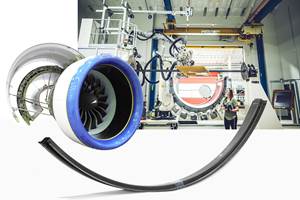Still working toward electric aircraft
A lot of research effort continues on electric propulsion for aircraft; many programs are aimed at developing viable battery-electric or solar propulsion for smaller aircraft.
As defined in a 2010 technical paper authored by Hyun Dae Kim of NASA Glenn Research Center (Cleveland, OH, US), a distributed electric propulsion system means integrating a propulsion system within an airframe such that the aircraft gets the full synergistic benefits of coupling of the airframe aerodynamics and the propulsion thrust stream by distributing thrust using many propulsors on the airframe. OK, in other words, the X-57 will have many small battery-powered electric motors, 14 in all, distributed along the length of the wing (12 high-lift motors along the leading edge of the wing and two larger wingtip cruise motors). NASA says the X-57 will undergo as many as three configurations, with the final configuration to feature 14 electric motors and propellers. The 12 smaller electric motors will be used to generate lift during takeoff and landing only, while the two wingtip motors will be used during cruise. The goal of the X-57 program is to demonstrate a 500% increase in high-speed cruise efficiency, zero in-flight carbon emissions, and flight that is much quieter for the community on the ground.
NASA chose the Tecnam (Capua, Italy) P2006T twin-engine, high-wing aircraft for the X-57, in part because the all-aluminum P2006T is the lightest certified commercial twin in existence. Two P2006T fuselages have already been shipped to the US and are undergoing a series of planned modifications and tests, which will culminate in the integration of a carbon composite wing, with integrated motors, that has already undergone low-speed ground testing using a modified big rig truck at Edwards AFB. NASA says the experimental, high-aspect ratio wing will feature a large reduction in area, with wing loading increasing from 17 pounds per square foot to 45 pounds per square foot. These changes will produce more efficient cruise flight by decreasing friction drag. NASA plans to demonstrate, soon, that the high-aspect ratio wing with the integrated high-lift motor system will allow the X-57 to take off and land at the same speed as the baseline P2006T, which will make the aircraft less sensitive to gusts and turbulence, leading to a smoother flight.
The wing is being designed at NASA Langley in Virginia, and fabricated by Xperimental (San Luis Obispo, CA, US). The wing will be integrated onto the fuselage once the electric power validation flights are complete. The battery system was developed by Electric Power Systems (City of Industry, CA, US).
This trend toward electric aircraft is will be something I’ll continue to follow. It’ll be interesting to see how it gets applied to the next generations of single-aisle commercial aircraft. Here’s a video of the X-57 Maxwell concept:
Related Content
Carbon fiber, bionic design achieve peak performance in race-ready production vehicle
Porsche worked with Action Composites to design and manufacture an innovative carbon fiber safety cage option to lightweight one of its series race vehicles, built in a one-shot compression molding process.
Read MoreBladder-assisted compression molding derivative produces complex, autoclave-quality automotive parts
HP Composites’ AirPower technology enables high-rate CFRP roof production with 50% energy savings for the Maserati MC20.
Read MorePrepreg compression molding supports higher-rate propeller manufacturing
To meet increasing UAV market demands, Mejzlik Propellers has added a higher-rate compression molding line to its custom CFRP propeller capabilities.
Read MoreThe potential for thermoplastic composite nacelles
Collins Aerospace draws on global team, decades of experience to demonstrate large, curved AFP and welded structures for the next generation of aircraft.
Read MoreRead Next
Scaling up, optimizing the flax fiber composite camper
Greenlander’s Sherpa RV cab, which is largely constructed from flax fiber/bio-epoxy sandwich panels, nears commercial production readiness and next-generation scale-up.
Read MoreCutting 100 pounds, certification time for the X-59 nose cone
Swift Engineering used HyperX software to remove 100 pounds from 38-foot graphite/epoxy cored nose cone for X-59 supersonic aircraft.
Read MoreUltrasonic welding for in-space manufacturing of CFRTP
Agile Ultrasonics and NASA trial robotic-compatible carbon fiber-reinforced thermoplastic ultrasonic welding technology for space structures.
Read More












